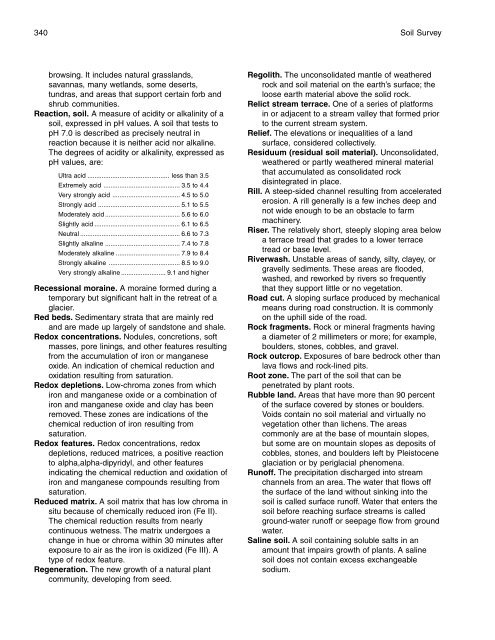Soil Survey of Sweet Grass County Area, Montana - Soil Data Mart
Soil Survey of Sweet Grass County Area, Montana - Soil Data Mart
Soil Survey of Sweet Grass County Area, Montana - Soil Data Mart
You also want an ePaper? Increase the reach of your titles
YUMPU automatically turns print PDFs into web optimized ePapers that Google loves.
340 <strong>Soil</strong> <strong>Survey</strong><br />
browsing. It includes natural grasslands,<br />
savannas, many wetlands, some deserts,<br />
tundras, and areas that support certain forb and<br />
shrub communities.<br />
Reaction, soil. A measure <strong>of</strong> acidity or alkalinity <strong>of</strong> a<br />
soil, expressed in pH values. A soil that tests to<br />
pH 7.0 is described as precisely neutral in<br />
reaction because it is neither acid nor alkaline.<br />
The degrees <strong>of</strong> acidity or alkalinity, expressed as<br />
pH values, are:<br />
Ultra acid .............................................. less than 3.5<br />
Extremely acid ........................................... 3.5 to 4.4<br />
Very strongly acid ...................................... 4.5 to 5.0<br />
Strongly acid .............................................. 5.1 to 5.5<br />
Moderately acid .......................................... 5.6 to 6.0<br />
Slightly acid ................................................ 6.1 to 6.5<br />
Neutral ........................................................ 6.6 to 7.3<br />
Slightly alkaline .......................................... 7.4 to 7.8<br />
Moderately alkaline .................................... 7.9 to 8.4<br />
Strongly alkaline ........................................ 8.5 to 9.0<br />
Very strongly alkaline ......................... 9.1 and higher<br />
Recessional moraine. A moraine formed during a<br />
temporary but significant halt in the retreat <strong>of</strong> a<br />
glacier.<br />
Red beds. Sedimentary strata that are mainly red<br />
and are made up largely <strong>of</strong> sandstone and shale.<br />
Redox concentrations. Nodules, concretions, s<strong>of</strong>t<br />
masses, pore linings, and other features resulting<br />
from the accumulation <strong>of</strong> iron or manganese<br />
oxide. An indication <strong>of</strong> chemical reduction and<br />
oxidation resulting from saturation.<br />
Redox depletions. Low-chroma zones from which<br />
iron and manganese oxide or a combination <strong>of</strong><br />
iron and manganese oxide and clay has been<br />
removed. These zones are indications <strong>of</strong> the<br />
chemical reduction <strong>of</strong> iron resulting from<br />
saturation.<br />
Redox features. Redox concentrations, redox<br />
depletions, reduced matrices, a positive reaction<br />
to alpha,alpha-dipyridyl, and other features<br />
indicating the chemical reduction and oxidation <strong>of</strong><br />
iron and manganese compounds resulting from<br />
saturation.<br />
Reduced matrix. A soil matrix that has low chroma in<br />
situ because <strong>of</strong> chemically reduced iron (Fe II).<br />
The chemical reduction results from nearly<br />
continuous wetness. The matrix undergoes a<br />
change in hue or chroma within 30 minutes after<br />
exposure to air as the iron is oxidized (Fe III). A<br />
type <strong>of</strong> redox feature.<br />
Regeneration. The new growth <strong>of</strong> a natural plant<br />
community, developing from seed.<br />
Regolith. The unconsolidated mantle <strong>of</strong> weathered<br />
rock and soil material on the earth’s surface; the<br />
loose earth material above the solid rock.<br />
Relict stream terrace. One <strong>of</strong> a series <strong>of</strong> platforms<br />
in or adjacent to a stream valley that formed prior<br />
to the current stream system.<br />
Relief. The elevations or inequalities <strong>of</strong> a land<br />
surface, considered collectively.<br />
Residuum (residual soil material). Unconsolidated,<br />
weathered or partly weathered mineral material<br />
that accumulated as consolidated rock<br />
disintegrated in place.<br />
Rill. A steep-sided channel resulting from accelerated<br />
erosion. A rill generally is a few inches deep and<br />
not wide enough to be an obstacle to farm<br />
machinery.<br />
Riser. The relatively short, steeply sloping area below<br />
a terrace tread that grades to a lower terrace<br />
tread or base level.<br />
Riverwash. Unstable areas <strong>of</strong> sandy, silty, clayey, or<br />
gravelly sediments. These areas are flooded,<br />
washed, and reworked by rivers so frequently<br />
that they support little or no vegetation.<br />
Road cut. A sloping surface produced by mechanical<br />
means during road construction. It is commonly<br />
on the uphill side <strong>of</strong> the road.<br />
Rock fragments. Rock or mineral fragments having<br />
a diameter <strong>of</strong> 2 millimeters or more; for example,<br />
boulders, stones, cobbles, and gravel.<br />
Rock outcrop. Exposures <strong>of</strong> bare bedrock other than<br />
lava flows and rock-lined pits.<br />
Root zone. The part <strong>of</strong> the soil that can be<br />
penetrated by plant roots.<br />
Rubble land. <strong>Area</strong>s that have more than 90 percent<br />
<strong>of</strong> the surface covered by stones or boulders.<br />
Voids contain no soil material and virtually no<br />
vegetation other than lichens. The areas<br />
commonly are at the base <strong>of</strong> mountain slopes,<br />
but some are on mountain slopes as deposits <strong>of</strong><br />
cobbles, stones, and boulders left by Pleistocene<br />
glaciation or by periglacial phenomena.<br />
Run<strong>of</strong>f. The precipitation discharged into stream<br />
channels from an area. The water that flows <strong>of</strong>f<br />
the surface <strong>of</strong> the land without sinking into the<br />
soil is called surface run<strong>of</strong>f. Water that enters the<br />
soil before reaching surface streams is called<br />
ground-water run<strong>of</strong>f or seepage flow from ground<br />
water.<br />
Saline soil. A soil containing soluble salts in an<br />
amount that impairs growth <strong>of</strong> plants. A saline<br />
soil does not contain excess exchangeable<br />
sodium.
















